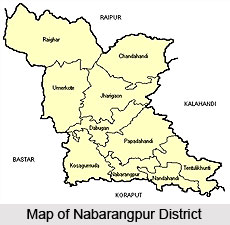 People of Nabarangpur district constitute of several tribes, such as Paraja, Kondhas, Gadava, Bhumias and Dombs. There are also nomadic and aboriginal inhabitants dwelling in this district of Orissa. Encounter with the civilised population in the township has changed the lifestyle of the people to some extent but tribes like Paraja, Kondhas and Gadava still prefer to live in the primitive life style. They mostly depend on cultivation and forest products.
People of Nabarangpur district constitute of several tribes, such as Paraja, Kondhas, Gadava, Bhumias and Dombs. There are also nomadic and aboriginal inhabitants dwelling in this district of Orissa. Encounter with the civilised population in the township has changed the lifestyle of the people to some extent but tribes like Paraja, Kondhas and Gadava still prefer to live in the primitive life style. They mostly depend on cultivation and forest products.
Majority of the population speak a distorted form of Oriya, which is difficult for the chaste Oriya speaking people to understand. They are an admixture of several words and phrases from aboriginal parlance. Boarder areas have a heavy dosage of Chattishgarhi language in the west and of Kalahandi dialect in the north. Three main religions dominate the district of Nabarangpur, which are Hindus, Christians and Muslims. The tribal worship the Hindu gods. The Mohammedans, though small in population are supposed to be the descendents of soldiers from Golkonda who invaded Jeypore. Some had settled down, married Paraja women and followed the Muslim festivals. The Christians are direct result of the Lutheren Mission Conversion. The American and German missionaries had a field day during the British Raj. They set up schools with boarding houses, dispensaries and built Churches. Protestants Catholic and other denomination of Christian are prevalent here. The Christian hospital of Nabarangpur town has been an attraction for patients from far-flung areas.
Bhumias and Dombs are among the other tribes dwelling in this district. Dombs are scattered throughout the district and enjoy the status next to the Kondhas. They are weavers and drummers by profession and enjoy great authority over others. The Dombs are engaged in cattle trade. The Mirganis are sub caste of Dombs. They earn their livelihood by cultivation and weaving. In the upper rank of the social scale we come across Sankharies, who deal with lac and who make basket, chains and dolls out of it. They are good artists, artisans and traders. Malis originally grow and collect flowers for temple worship. They have now switched over to cultivation of Sugarcane, tobacco etc. on the banks of Indravati river. Sundhis are well-known for distillation and selling of liquor. Tradition holds that they are the descendants of a Brahmin father and royal mother. They are generally affluent and prosperous in status.



















